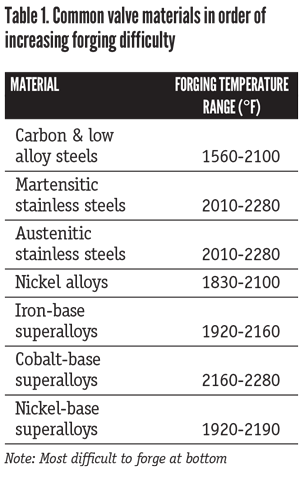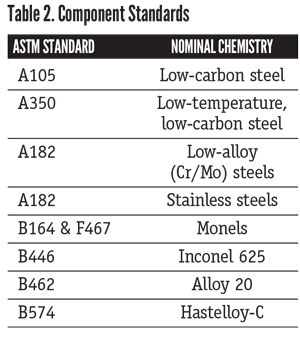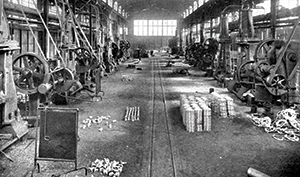Forgings: Higher Quality with a Cost
While the words “cast” and “steel” often go together in the valve world, so do “forged” and “steel.” Forged steel valves are a cornerstone of the world’s valve inventory.
#materials
Because of the cost.
Before we talk about the specifics of cast vs. forged, we need to discuss forgings, the forging process itself and how it differs from casting.
THE PROCESS
Other cast items include billets and bars—solid, round, square or rectangular pieces of steel often re-processed into smaller strips and sheets.
Such bars and billets are also used as the base material for forging valve components. The forging process begins with a piece of previously “cast” then rolled steel. This initial rolling or forming process realigns the grain structure of the initial molten metallic mixture into a more linear pattern.
For forging, billet or bar pieces are cut to length and then heated to the plastic or forging temperature of the specific metal or steel alloy. The piece is then placed into a press, where tons—and sometimes tens of thousands of tons—of force are used to mash the soft billet or bar into the void of the casting dies.
Two types of dies are used in the valve component forging process. The first is “open-die,” for which the forging process yields a part close to the desired shape and geometry. The second is “closed-die,” which can yield parts that require minimal machining. The closed-die process yields a part with some exterior flash around its periphery that needs to be removed in a second pressing operation. After the part has been forged and the flash removed, it is ready for post-weld heat treatment, if required, and then final machining to shape.
The forging process is ideally suited to smaller valve components because of the cost of the dies as well as the cost of the forging process itself. Dies have to be machined from very hard materials that have a plastic temperature range well above that of the pre-heated forging billet or bar. Because the pressing operation is so violent, the dies have a short life-span and must be either repaired or replaced at regular intervals.
MATERIALS AND TYPES
While some super-large forging presses can accommodate large valve components up to NPS 24, these machines are rare, and the cost to produce high-quality, open-die valve forgings on them is very high. Therefore, most forged steel valves fall in the
NPS 2 and below range. For the most part, forgings of this size are more cost effective than castings.
The most popular forged-steel valves are the compact gate, globe and check valves built to the American Petroleum Institute (API) standard 602, Steel Gate, Globe and Check Valves for Sizes NPS 4 and Smaller for the Petroleum and Natural Gas Industries.
Since manufacturing runs of these alloys usually are shorter, it often is quicker and cheaper to use castings for small valve components of Monel, Hastelloy, Inconel and other exotic materials. Also, some of these alloys are much harder than plain carbon and low-alloy steels. Forging dies for them can be extremely expensive to make. Instead, short runs of API 602 valves of these materials are often made of castings.
Although forgings are generally chosen because they are free of defects, castings might be chosen over forgings because of the extra machining processes required in finishing out a forged component. Because forgings are generally solid metallic components (without cavities or holes), all the flow-ways and internal openings have to be machined into the forging. With castings, they can have these ports, passageways and voids created in the cast component through the use of cores, which yield open space in the finished part. Because of this, the cost of removing large amounts of metal by machining in larger forged valve components has to be taken into consideration as well.
In some cases, manufacturers have resorted to exotic forging and piercing press operations for large-size forged valve bodies. These processes create the bulk of the valve passageway areas during the hot pressing process, eliminating much of the gross machining costs to remove this unwanted metal.
Some applications make using larger forged steel valve bodies an excellent choice. When an extremely high-integrity valve body is required, the large forged component sometimes comes out cheaper despite its requisite costs. This is because a casting requires much welding repair to bring it up to the same level of quality. For example, hydrogen service, with its need for the highest integrity valve bodies, is a perfect example where the large forged body is an excellent choice.
COMPONENT STANDARDS
While defects in forged steel valve components are rare, they occasionally occur, so specific nondestructive testing procedures are designed to detect those defects. These tests include magnetic particle examination and dye penetrant examination for the detection of surface defects and ultrasonic inspection for the detection of volumetric (internal) flaws. Most often, minute, very shallow cracks and laps are the surface defects found. Meanwhile, the interior defect most frequently seen is a flow-through crack or seam resulting from a defect in the original bar or billet.
CONCLUSION
If money was not an object in valve procurement, forging would probably be chosen over casting because of the much higher quality. However, castings and forgings both have a place in the world of valve component manufacturing. Also, many times a valve will contain both castings and forgings. For small valves, the choice of which process to choose, forging or casting, is usually an economic one. Yet sometimes the cost analysis is a toss-up, leaving the amount of production time required for each process as the determining factor in choosing a casting over a forging.
This is part two of a two-part primer on casting/forging. Part one appeared in the Fall 2014 VALVE Magazine.
GREG JOHNSON is president of United Valve (www.unitedvalve.com) in Houston. He is a contributing editor to VALVE Magazine, a past chairman of the Valve Repair Council and a current VRC board member. He also serves as chairman of VMA’s Education & Training Committee, is vice chairman of VMA’s Communications Committee and is president of the Manufacturers Standardization Society. Reach him at greg1950@unitedvalve.com.
RELATED CONTENT
-
The Limits of Standard Manual Globe Valves for Throttling
A common practice in process services is to use manual globe valves with hand wheels for regulating flow.
-
The Biggest Valves: Sizes Growing in Step with Greater Demand
Valve manufacturers that have the expertise, skills, equipment and facilities to produce large valves are rare.
-
The Role of Valves in HAZOP Studies
Process hazard analysis (PHA) is required by U.S.











 Unloading large gate valve.jpg;maxWidth=214)


